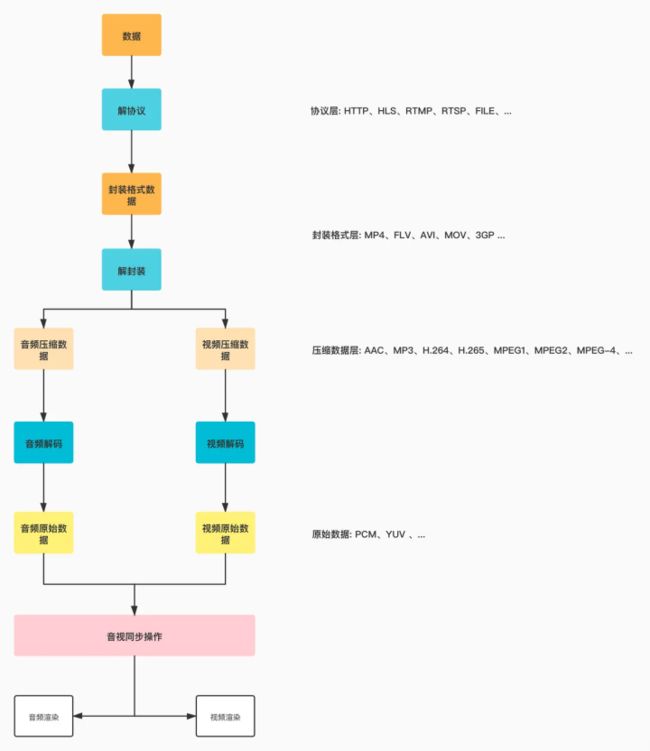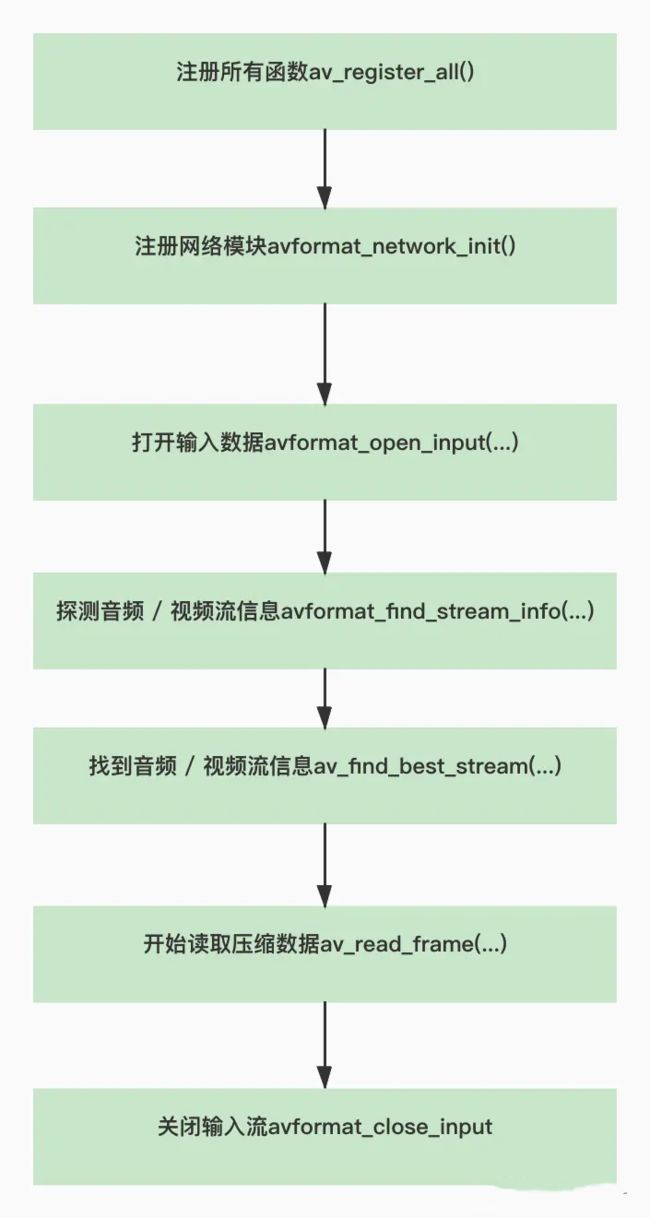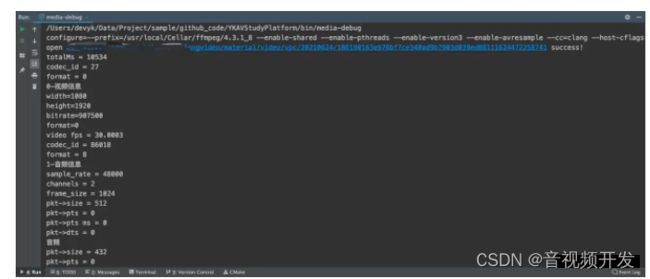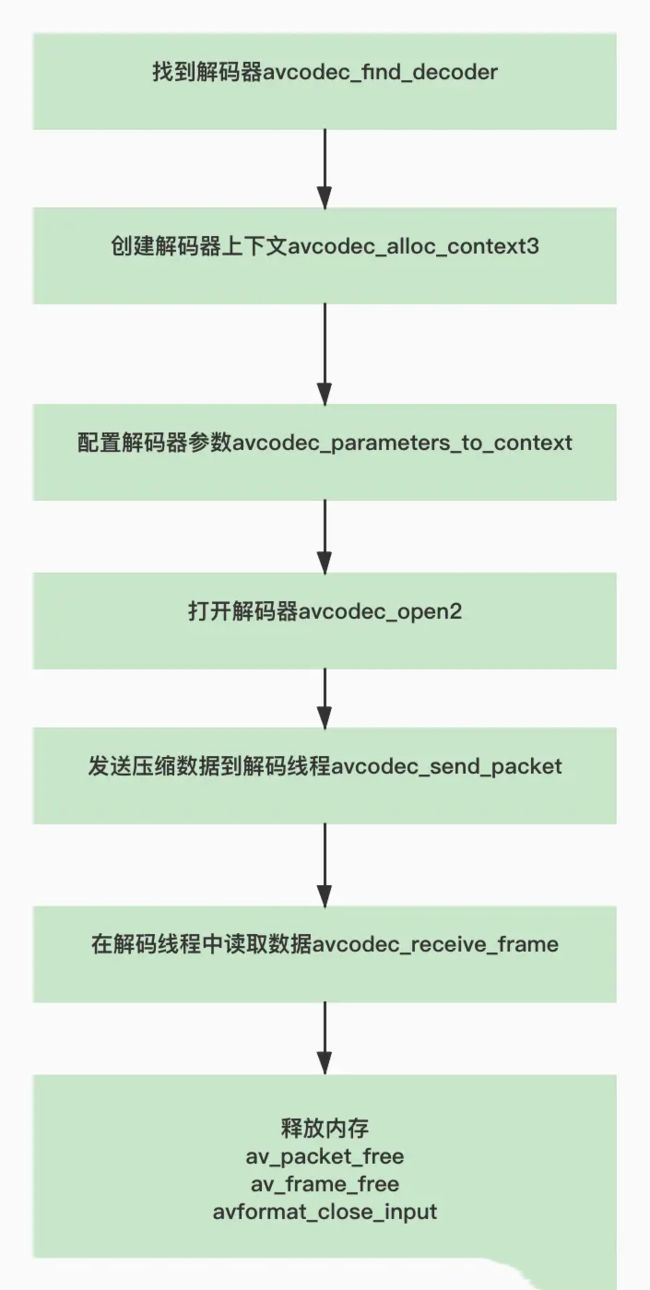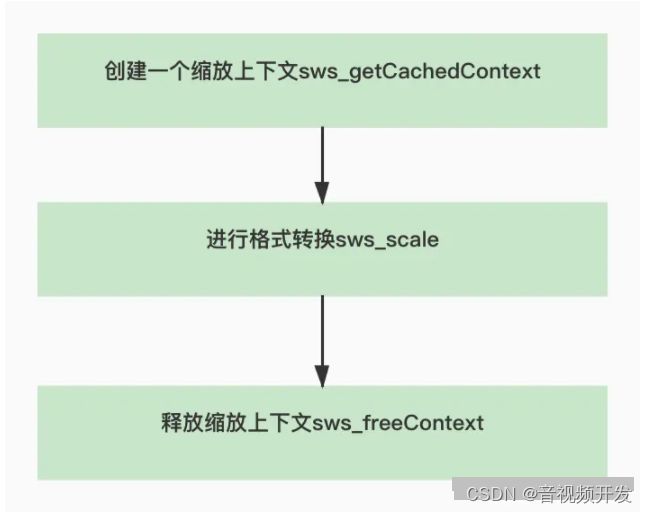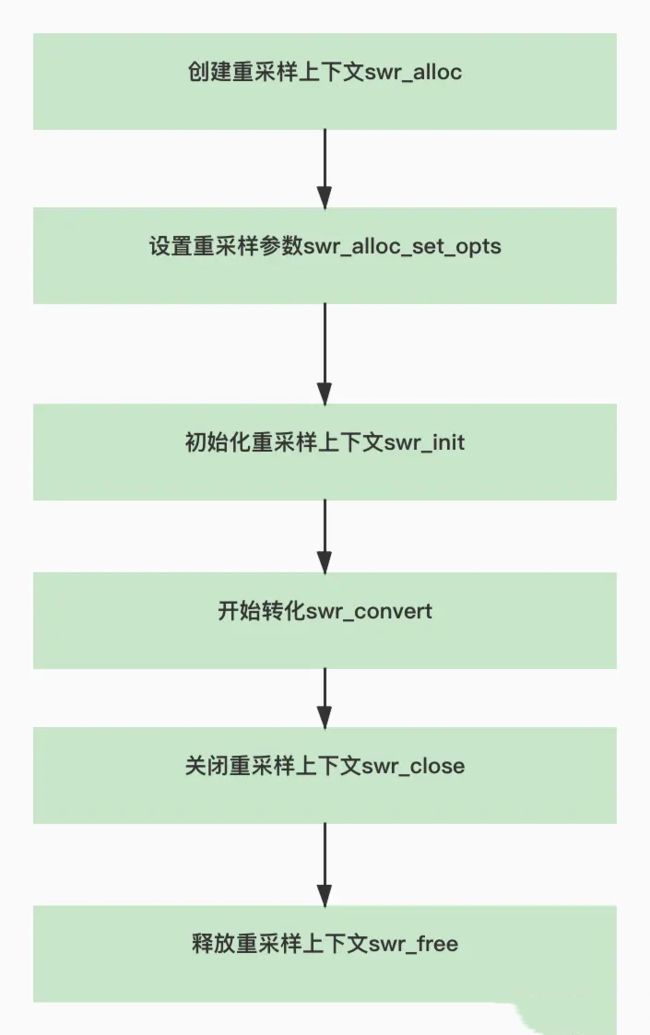跨平台播放器开发,开发一个播放器需要用到的FFmpeg知识
咱们先来看一个流程图:
该系列文章就是将上图拆分为具体的代码模块,那么该篇咱们主要讲解如何利用 FFmpeg API 来对一个输入数据进行解封装,读取原始音频视频信息,然后对音频视频做一些基本操作。基本上在播放器模块中用到的 FFmpeg API 咱们都要对它有一个了解。
FFmpeg 基础知识
解封装
利用 FFmpeg api 来对输入视频进行解封装,先来看一下使用 api 的流程
看完上图是不是对解封装的 API 有一个大概的了解? 从一个 输入 URL 到读取到 压缩数据流 就这么几步,很简单的,下面我们用代码实际演示一下:
本文福利, 免费领取C++音视频学习资料包、技术视频,内容包括(音视频开发,面试题,FFmpeg ,webRTC ,rtmp ,hls ,rtsp ,ffplay ,编解码,推拉流,srs)↓↓↓↓↓↓见下面↓↓文章底部点击免费领取↓↓
1.注册所有函数
av_register_all()其实在最新的版本中该函数已经过时了,在最低的版本中还是必须调用该函数的。
2.注册网络模块
//初始化网络库(可以打开 rtmp、rtsp、http 等协议的流媒体视频)
avformat_network_init();3.打开输入流并读取头信息
//参数设置
AVDictionary *opts = NULL;
//设置rtsp流已tcp协议打开
av_dict_set(&opts, "rtsp_transport", "tcp", 0);
//网络延时时间
av_dict_set(&opts, "max_delay", "1000", 0);
//解封装上下文
AVFormatContext *ic = NULL;
int re = avformat_open_input(
&ic,
inpath,
0, // 0表示自动选择解封器
&opts //参数设置,比如rtsp的延时时间
);
//返回值 0 成功
if (re != 0) {
char buf[1024] = {0};
av_strerror(re, buf, sizeof(buf) - 1);
cout << "open " << inpath << " failed! :" << buf << endl;
getchar();
return -1;
}这里要注意,调用该函数那么在结尾处一定要调用 avformat_close_input()
4.读取媒体文件数据包
//return >=0 if OK, AVERROR_xxx on error
re = avformat_find_stream_info(ic, 0);
//打印视频流详细信息
av_dump_format(ic, 0, inpath, 0);
5.获取音视频流信息
- 通过遍历的方式获取
//获取音视频流信息 (遍历,函数获取)
for (int i = 0; i < ic->nb_streams; i++) {
AVStream *as = ic->streams[i];
cout << "codec_id = " << as->codecpar->codec_id << endl;
cout << "format = " << as->codecpar->format << endl;
//音频 AVMEDIA_TYPE_AUDIO
if (as->codecpar->codec_type == AVMEDIA_TYPE_AUDIO) {
audioStream = i;
cout << i << "音频信息" << endl;
cout << "sample_rate = " << as->codecpar->sample_rate << endl;
//AVSampleFormat;
cout << "channels = " << as->codecpar->channels << endl;
//一帧数据?? 单通道样本数
cout << "frame_size = " << as->codecpar->frame_size << endl;
//1024 * 2 * 2 = 4096 fps = sample_rate/frame_size
}
//视频 AVMEDIA_TYPE_VIDEO
else if (as->codecpar->codec_type == AVMEDIA_TYPE_VIDEO) {
videoStream = i;
cout << i << "视频信息" << endl;
cout << "width=" << as->codecpar->width << endl;
cout << "height=" << as->codecpar->height << endl;
//帧率 fps 分数转换
cout << "video fps = " << r2d(as->avg_frame_rate) << endl;
}
}
- 2通过 API 方式获取
//获取视频流
videoStream = av_find_best_stream(ic, AVMEDIA_TYPE_VIDEO, -1, -1, NULL, 0);
AVStream *as = ic->streams[videoStream];
cout << i << "视频信息" << endl;
cout << "width=" << as->codecpar->width << endl;
cout << "height=" << as->codecpar->height << endl;
//帧率 fps 分数转换
cout << "video fps = " << r2d(as->avg_frame_rate) << endl;
6.读取压缩数据包
AVPacket *pkt = av_packet_alloc();
for (;;) {
int re = av_read_frame(ic, pkt);
if (re != 0) {
//循环播放
cout << "==============================end==============================" << endl;
break;
}
cout << "pkt->size = " << pkt->size << endl;
//显示的时间
cout << "pkt->pts = " << pkt->pts << endl;
//转换为毫秒,方便做同步
cout << "pkt->pts ms = " << pkt->pts * (r2d(ic->streams[pkt->stream_index]->time_base) * 1000) << endl;
//解码时间
cout << "pkt->dts = " << pkt->dts << endl;
if (pkt->stream_index == videoStream) {
cout << "图像" << endl;
}
if (pkt->stream_index == audioStream) {
cout << "音频" << endl;
}
//释放,引用计数-1 为0释放空间
av_packet_unref(pkt);
}
调试之后的 log
解码
调用 ·ffmpeg api 来对音视频压缩数据解码的话,其实也很简单,主要使用如下几个 api ,见下图:
我们接着在解封装的代码基础上进行添加,代码如下:
//找到视频解码器
AVCodec *vcodec = avcodec_find_decoder(ic->streams[videoStream]->codecpar->codec_id);
if (!vcodec) {
cout << "can't find the codec id" << ic->streams[videoStream]->codecpar->codec_id << endl;
getchar();
return -1;
}
//创建视频解码器上下文
AVCodecContext *vctx = avcodec_alloc_context3(vcodec);
//配置解码器上下文参数
avcodec_parameters_to_context(vctx, ic->streams[videoStream]->codecpar);
//配置解码线程
vctx->thread_count = 8;
//打开解码器上下文
re = avcodec_open2(vctx, 0, 0);
if (re != 0) {
char buf[1024] = {0};
av_strerror(re, buf, sizeof(buf) - 1);
cout << "video avcodec_open2 failed!" << buf << endl;
getchar();
return -1;
}
cout << "video avcodec_open2 success!" << endl;
找解码器也可以通过如下 API 形式进行:
AVCodec *avcodec_find_decoder_by_name(const char *name);如果想要打开音频解码器,代码一样,换下参数即可,下面进行真正解码:
//malloc AVPacket并初始化 AVPacket *pkt = av_packet_alloc(); //接收解码的原始数据 AVFrame *frame = av_frame_alloc(); for (;;) { int re = av_read_frame(ic, pkt); if (re != 0) { break; } //解码视频 //发送 packet 到解码线程 re = avcodec_send_packet(avcc, pkt); //释放,引用计数-1 为0释放空间 av_packet_unref(pkt); //一次 send 可能对于多次 receive for (;;) { re = avcodec_receive_frame(avcc, frame); if (re != 0)break; //释放,引用计数-1 为0释放空间 av_frame_unref(frame); }
这样就可以进行解码了,现在我们添加一些打印参数,比如音频采样信息,视频宽高信息:
总时长:totalMs = 10534 ms视频信息:bitrate=907_500fps = 30.0003codec_id = 86018format = AV_PIX_FMT_YUV420P 11521080 - 1920pict_type= AV_PICTURE_TYPE_I音频信息:sample_rate = 48000channels = 2
视频像素格式转换
视频像素格式其实就是 YUV 转 RGB 的一个过程, FFmpeg 也提供了对应的 API ,它是使用 CPU 运算能力来转换,效率是比较低的。咱们播放器使用 OpenGL GPU 来转,效率比较高。虽然 FFmpeg API 转换效率比较低,但是我们还是可以学习一下的。使用流程如下:
仅仅 2 个 API 就可以达到对 YUV 的转换或者裁剪,代码示例:
const int in_width = frame->width; const int in_height = frame->height; const int out_width = in_width / 2; const int out_height = in_height / 2; /** * @param context : 缩放上下文,如果为 NULL,那么内部会进行创建, * 如果已经存在,参数也没有发生变化,那么就直接返回当前,否者释放缩放上下文,重新创建。 * @param srcW : 输入的宽 * @param srcH : 输入的高 * @param srcFormat : 输入的格式 * @param dstW : 输出的宽 * @param dstH : 输出的高 * @param dstFormat : 输出的格式 * @param flags : 提供了一系列的算法,快速线性,差值,矩阵,不同的算法性能也不同, 快速线性算法性能相对较高。只针对尺寸的变换。 * @param srcFilter : 输入过滤器 * @param dstFilter : 输出过滤器 * @param param : 这个跟 flags 算法相关,一般传入 O * @return : 缩放的上下文 */ vsctx = sws_getCachedContext( vsctx,//传入NULL 会新创建 in_width, in_height, (AVPixelFormat) frame->format, //输入的宽高,格式 out_width, out_height, AV_PIX_FMT_RGBA, //输出的宽高,格式 SWS_BILINEAR, //尺寸变换的算法 0, 0, 0 ); /** * @param c 缩放上下文 * @param srcSlice YUV 切换数据可以是指针,也可以是数组 * @param srcStride 对应 YUV 一行的大小 * @param srcSliceY 这个用不到传入 0 即可 * @param srcSliceH YUV 的高 * @param dst 输出的像素格式数据 * @param dstStride 输出的像素格式数据的大小 * @return 返回转换后的高 */ re = sws_scale(vsctx, frame->data, //输入数据 frame->linesize,//输入行大小 0, frame->height,//输出高度 (uint8_t *const *) (data), //输出数据 lines//输出大小 );
上面的注释都很详细,相信大家也能看的明白,最后我们看下调试后的log,如下:
像素格式尺寸转换上下文创建或者获取成功!in_width=1080in_height=1920out_width=540out_height=960sws_scale success! return height of the output slice =960==============================end==============================
重采样
重采样的意思就是将音频的输入参数统一输出某个特定的值,这样做的好处就是归一化播放器的声音输出。那么怎么使用 FFmpeg API 来进行重采样呢? 先来看一张流程图:
我们还是以之前的代码继续写,
我们统一输出的参数为 sample_rate=48000,sample_channel=2,sample_fml=AV_SAMPLE_FMT_S16
... //音频重采样 SwrContext *asctx = swr_alloc(); //设置重采样参数 asctx = swr_alloc_set_opts(asctx //重采样上下文 , av_get_default_channel_layout(2)//输出声道格式 , AV_SAMPLE_FMT_S16 //输出声音样本格式 , 48000 //输出采样率 , av_get_default_channel_layout(actx->channels)//输入通道数 , actx->sample_fmt //输入声音样本格式 , actx->sample_rate, 0, 0 //输入音频采样率 ); //初始化采样上下文 re = swr_init(asctx); if (re != 0) { char buf[1024] = {0}; av_strerror(re, buf, sizeof(buf) - 1); cout << "audio swr_init failed!" << buf << endl; return -1; } ... //重采样之后存入的数据 unsigned char *pcm = NULL; for (;;) { int re = av_read_frame(ic, pkt); if (re != 0) { //循环播放 cout << "==============================end==============================" << endl;// int ms = 3000; //三秒位置 根据时间基数(分数)转换// long long pos = (double) ms / (double) 1000 * r2d(ic->streams[pkt->stream_index]->time_base);// av_seek_frame(ic, videoStream, pos, AVSEEK_FLAG_BACKWARD | AVSEEK_FLAG_FRAME);// continue; break; } cout << "pkt->size = " << pkt->size << endl; //显示的时间 cout << "pkt->pts = " << pkt->pts << endl; //转换为毫秒,方便做同步 cout << "pkt->pts ms = " << pkt->pts * (r2d(ic->streams[pkt->stream_index]->time_base) * 1000) << endl; //解码时间 cout << "pkt->dts = " << pkt->dts << endl; AVCodecContext *avcc = NULL; if (pkt->stream_index == videoStream) { cout << "图像" << endl; avcc = vctx; } if (pkt->stream_index == audioStream) { cout << "音频" << endl; avcc = actx; } //解码视频 //发送 packet 到解码线程 re = avcodec_send_packet(avcc, pkt); //释放,引用计数-1 为0释放空间 av_packet_unref(pkt); if (re != 0) { char buf[1024] = {0}; av_strerror(re, buf, sizeof(buf) - 1); cout << "video avcodec_send_packet failed!" << buf << endl; continue; } //一次 send 可能对于多次 receive for (;;) { re = avcodec_receive_frame(avcc, frame); if (re != 0)break; ... if (avcc == actx) {//音频 uint8_t *data[2] = {0}; if (!pcm) pcm = new uint8_t[frame->nb_samples * 16/8 * 2]; data[0] = {pcm}; int len = swr_convert(asctx, data, frame->nb_samples //输出 , (const uint8_t **) frame->data, frame->nb_samples //输入 ); if (len >= 0) { cout << "swr_convert success return len = " << len << endl; } else { cout << "swr_convert failed return len = " << len << endl; } } } ... } if (asctx)swr_close(asctx); if (asctx)swr_free(&asctx);
转换后的log:
swr_convert success return len = 1024
seek 操作
我们如果想要指定某个时间看某段画面的话就需要对视频做 seek 操作,FFmpeg 提供了 av_seek_frame 函数来对视频的跳转,它有 4 个输入参数,含义如下:
/**
* 根据时间戳和音频或视频的索引 seek 到关键帧的操作
*
* @param s 媒体格式上下文
* @param stream_index 流索引,传入 -1 为默认
* @param timestamp 需要跳转到时间戳的位置
* @param flags seek 的模式
* @return >= 0 on success
*/
int av_seek_frame(AVFormatContext *s, int stream_index, int64_t timestamp,
int flags);
我们着重看下最后一个 flags 参数
//AVSEEK_FLAG_BACKWARD
seek 到后面的关键帧
//AVSEEK_FLAG_BYTE
基于以字节为单位的位置查找
//AVSEEK_FLAG_ANY
Seek 到任意一帧,注意不是关键帧,那么会有花屏的可能。
//AVSEEK_FLAG_FRAME
seek 到关键帧的位置
我们一般以这样的形式来进行 seek 操作:
int ms = 3000; //三秒位置 根据时间基数(分数)转换
long long pos = (double) ms / (double) 1000 * r2d(ic->streams[pkt->stream_index]->time_base);
av_seek_frame(ic, videoStream, pos, AVSEEK_FLAG_BACKWARD | AVSEEK_FLAG_FRAME);
上面的含义就是定位到 3000 ms 位置后面的关键帧处开始播放。后面播放器 seek 功能的时候我们会介绍如何精准 seek 操作 该篇文章对于 FFmpeg 的知识我们就介绍到这里,后面在开发中如果有新遇见的我会再详细介绍一下。 总结 播放器要用到的 FFmpeg 知识 大概就这么多,可以发现这些 API 其实都比较简单。此刻我相信你已经对这些 API 有一定的印象和了解了吧。
本文福利, 免费领取C++音视频学习资料包、技术视频,内容包括(音视频开发,面试题,FFmpeg ,webRTC ,rtmp ,hls ,rtsp ,ffplay ,编解码,推拉流,srs)↓↓↓↓↓↓见下面↓↓文章底部点击免费领取↓↓
